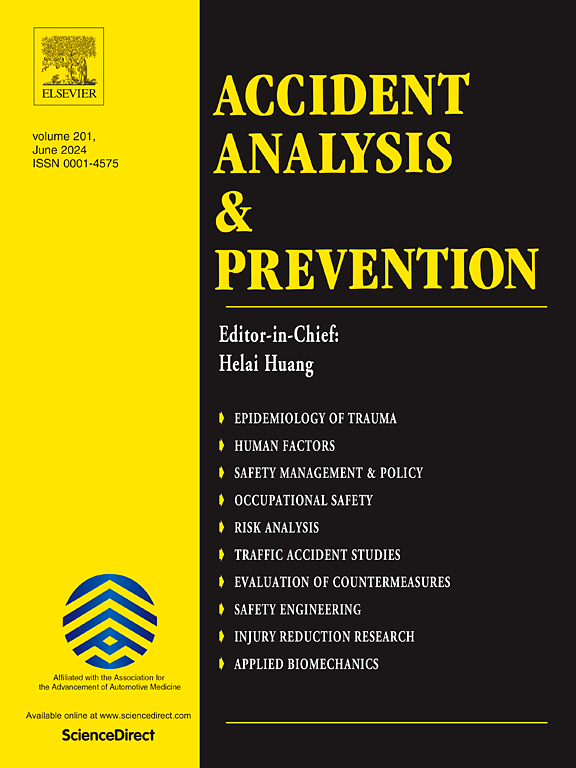Reliable crash analysis: Comparing biases and error rates of empirical Bayes before-after analyses to mixed-models
IF 5.7
1区 工程技术
Q1 ERGONOMICS
引用次数: 0
Abstract
Estimating reliable causal estimates of road safety interventions is challenging, with a number of these challenges addressable through analysis choices. At a minimum, developing reliable crash modification factors (CMFs) needs to address three critical confounding factors, i.e., 1) the regression-to-the-mean (RTM) phenomenon, 2) the effect of traffic volume, and 3) the time trend for the occurrence of crashes. The current preferred crash analysis method is the empirical Bayes (EB) before-after analysis but requires complex bespoke analysis and may not be the best performing method. We compare in a simulation experiment various EB methods to a more straightforward negative binomial generalized linear mixed model (NB-GLMM) with an interaction term between treatment group and time for analysing treatment effects in crash data. Data were simulated using two broad scenarios: 1) an idealized randomized controlled design, and 2) a moderately biased site-selection scenario commonly encountered in road safety crash analyses. Both scenarios varied treatment effects, overdispersion, and sample sizes. The NB-GLMM performed best, maintaining type I error rate and providing least biased estimates across most analyses. Most standard EB methods were too liberal or generally more biased, with the exception of the EB method that incorporated a varying dispersion parameter. Incorporating mixed-effects modelling into the EB procedure improved bias. Overall, we found that using a “standard” NB-GLMM with an interaction term is sufficient for crash analysis, reducing complexity compared to bespoke EB solutions. Chosen methods should also be the least biased and possess the marginal error rates under both ideal and selection-bias conditions. Mixed-effects approaches to analysis of road safety interventions satisfy these criteria outperforming standard or other empirical Bayes approaches tested here.
可靠的崩溃分析:比较经验贝叶斯前后分析和混合模型的偏差和错误率。
估计道路安全干预措施的可靠因果估计具有挑战性,其中一些挑战可以通过分析选择来解决。开发可靠的碰撞修正因子(CMFs)至少需要解决三个关键的混杂因素,即1)回归均值(RTM)现象,2)交通量的影响,以及3)碰撞发生的时间趋势。目前首选的碰撞分析方法是经验贝叶斯(EB)前后分析,但需要复杂的定制分析,可能不是最好的方法。在模拟实验中,我们将各种EB方法与更直接的负二项广义线性混合模型(NB-GLMM)进行比较,该模型具有治疗组和时间之间的相互作用项,用于分析碰撞数据中的治疗效果。数据采用两种场景进行模拟:1)理想随机对照设计,2)道路安全碰撞分析中常见的中度偏倚选址场景。这两种情况都改变了处理效果、过度分散和样本量。NB-GLMM表现最好,在大多数分析中保持I型错误率并提供最小偏差估计。大多数标准的EB方法过于自由或通常更偏向,除了EB方法纳入了不同的色散参数。将混合效应模型纳入EB程序可改善偏倚。总的来说,我们发现使用带有交互项的“标准”NB-GLMM足以进行崩溃分析,与定制的EB解决方案相比,降低了复杂性。所选择的方法在理想和选择偏差条件下都应具有最小的偏差和边际错误率。道路安全干预分析的混合效应方法满足这些标准,优于这里测试的标准或其他经验贝叶斯方法。
本文章由计算机程序翻译,如有差异,请以英文原文为准。
求助全文
约1分钟内获得全文
求助全文
来源期刊

Accident; analysis and prevention
Multiple-
CiteScore
11.90
自引率
16.90%
发文量
264
审稿时长
48 days
期刊介绍:
Accident Analysis & Prevention provides wide coverage of the general areas relating to accidental injury and damage, including the pre-injury and immediate post-injury phases. Published papers deal with medical, legal, economic, educational, behavioral, theoretical or empirical aspects of transportation accidents, as well as with accidents at other sites. Selected topics within the scope of the Journal may include: studies of human, environmental and vehicular factors influencing the occurrence, type and severity of accidents and injury; the design, implementation and evaluation of countermeasures; biomechanics of impact and human tolerance limits to injury; modelling and statistical analysis of accident data; policy, planning and decision-making in safety.
 求助内容:
求助内容: 应助结果提醒方式:
应助结果提醒方式:


